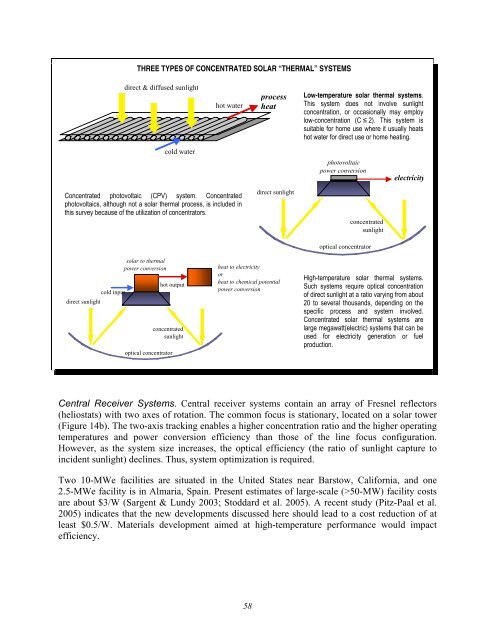Basic Research Needs for Solar Energy Utilization - Office of ...
Basic Research Needs for Solar Energy Utilization - Office of ...
Basic Research Needs for Solar Energy Utilization - Office of ...
You also want an ePaper? Increase the reach of your titles
YUMPU automatically turns print PDFs into web optimized ePapers that Google loves.
THREE TYPES OF CONCENTRATED SOLAR “THERMAL” SYSTEMS<br />
direct & diffused sunlight<br />
cold water<br />
hot water<br />
Concentrated photovoltaic (CPV) system. Concentrated<br />
photovoltaics, although not a solar thermal process, is included in<br />
this survey because <strong>of</strong> the utilization <strong>of</strong> concentrators.<br />
cold input<br />
direct sunlight<br />
solar to thermal<br />
power conversion<br />
hot output<br />
concentrated<br />
sunlight<br />
optical concentrator<br />
58<br />
process<br />
heat<br />
direct sunlight<br />
heat to electricity<br />
or<br />
heat to chemical potential<br />
power conversion<br />
Low-temperature solar thermal systems.<br />
This system does not involve sunlight<br />
concentration, or occasionally may employ<br />
low-concentration (C ≤ 2). This system is<br />
suitable <strong>for</strong> home use where it usually heats<br />
hot water <strong>for</strong> direct use or home heating.<br />
photovoltaic<br />
power conversion<br />
concentrated<br />
sunlight<br />
optical concentrator<br />
electricity<br />
High-temperature solar thermal systems.<br />
Such systems require optical concentration<br />
<strong>of</strong> direct sunlight at a ratio varying from about<br />
20 to several thousands, depending on the<br />
specific process and system involved.<br />
Concentrated solar thermal systems are<br />
large megawatt(electric) systems that can be<br />
used <strong>for</strong> electricity generation or fuel<br />
production.<br />
Central Receiver Systems. Central receiver systems contain an array <strong>of</strong> Fresnel reflectors<br />
(heliostats) with two axes <strong>of</strong> rotation. The common focus is stationary, located on a solar tower<br />
(Figure 14b). The two-axis tracking enables a higher concentration ratio and the higher operating<br />
temperatures and power conversion efficiency than those <strong>of</strong> the line focus configuration.<br />
However, as the system size increases, the optical efficiency (the ratio <strong>of</strong> sunlight capture to<br />
incident sunlight) declines. Thus, system optimization is required.<br />
Two 10-MWe facilities are situated in the United States near Barstow, Cali<strong>for</strong>nia, and one<br />
2.5-MWe facility is in Almaria, Spain. Present estimates <strong>of</strong> large-scale (>50-MW) facility costs<br />
are about $3/W (Sargent & Lundy 2003; Stoddard et al. 2005). A recent study (Pitz-Paal et al.<br />
2005) indicates that the new developments discussed here should lead to a cost reduction <strong>of</strong> at<br />
least $0.5/W. Materials development aimed at high-temperature per<strong>for</strong>mance would impact<br />
efficiency.
















